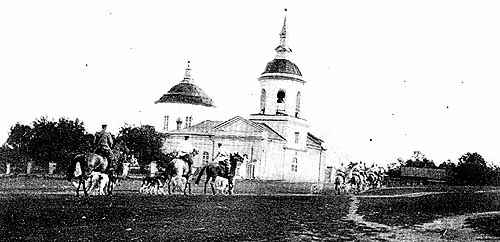Hunting with Borzoi on Russia's Steppes
By Joseph B. Thomas, JR.
Test and
photos by
courtesy of "The Illustrated Sporting News."
 N
THE Anglo-Saxon mind there hangs over Russia, its steppes, its people and
its pastimes, a shroud of mystery, a feeling that medieval conditions exist
in the realm of the Czar as in no other portion of the civilized world.
A wierd romantic halo seems to surround the story of the steppe or the
forest, and based on actual conditions this feeling has some real ground
for existence. In the world of sport in America there are but few pastimes
which date back many scores of years, but in Russia some of the sports
have been handed down from the nomad days of the peoples whose blood now
flows in the Slav race, and amongst these perhaps the most picturesque
are falconry and coursing, two sports which have existed since man was
man and had need of food. Coursing may justly be called the Russian national
sport, not but that coursing exists in other countries, but the method
of procedure in Russia is a method of its own.
N
THE Anglo-Saxon mind there hangs over Russia, its steppes, its people and
its pastimes, a shroud of mystery, a feeling that medieval conditions exist
in the realm of the Czar as in no other portion of the civilized world.
A wierd romantic halo seems to surround the story of the steppe or the
forest, and based on actual conditions this feeling has some real ground
for existence. In the world of sport in America there are but few pastimes
which date back many scores of years, but in Russia some of the sports
have been handed down from the nomad days of the peoples whose blood now
flows in the Slav race, and amongst these perhaps the most picturesque
are falconry and coursing, two sports which have existed since man was
man and had need of food. Coursing may justly be called the Russian national
sport, not but that coursing exists in other countries, but the method
of procedure in Russia is a method of its own.
In the old
days, before the freedom of the serfs in '61, there were many noblemen
who had from several hundred to a thousand dogs in their kennels; these
were principally of two breeds, the borzoi or Russian greyhounds, called
in America Russian wolf-hounds and fox hounds.

OFF TO THE HUNT. THE GRAND DUKE'S CHAPEL.
At the present day owing to the changed conditions, there are but few large
kennels left in Russia, but one, that of H. I. H., the Grand Duke Nicholas,
contains to-day five hundred hounds, and may be said to be the finest kennel
in the world.
To reach almost any nobleman's estate in Russia one has recourse to return
to original methods, taking a carriage journey of anywhere from a dozen
to a hundred versts and not an uninteresting experience it is.
The best hunting estates are situated to the south of Moscow, where the
country is open and marshes infrequent in the great provinces of Tula and
Tamboff. After perhaps a night's journey on the railroad from Moscow one
alights from the train to a breakfast of "chai and kleb" in the neat railway
restaurant, and without further delay is escorted to the carriage of his
host to which are harnessed three or four gray, black or roan stallions
abreast. In some instances the seigneur has a liking for some particular
color in horse flesh. In the case of the Grand Duke Nicholas all the carriage
and hunting horses are strawberry roans.
13.
Cover
1
2
3
4
5
6
7
8
9
10
11
12
13
14
15
16
17
18
19
20
Home
Copyright Rey and Yvonne McGehee 2000.
 N
THE Anglo-Saxon mind there hangs over Russia, its steppes, its people and
its pastimes, a shroud of mystery, a feeling that medieval conditions exist
in the realm of the Czar as in no other portion of the civilized world.
A wierd romantic halo seems to surround the story of the steppe or the
forest, and based on actual conditions this feeling has some real ground
for existence. In the world of sport in America there are but few pastimes
which date back many scores of years, but in Russia some of the sports
have been handed down from the nomad days of the peoples whose blood now
flows in the Slav race, and amongst these perhaps the most picturesque
are falconry and coursing, two sports which have existed since man was
man and had need of food. Coursing may justly be called the Russian national
sport, not but that coursing exists in other countries, but the method
of procedure in Russia is a method of its own.
N
THE Anglo-Saxon mind there hangs over Russia, its steppes, its people and
its pastimes, a shroud of mystery, a feeling that medieval conditions exist
in the realm of the Czar as in no other portion of the civilized world.
A wierd romantic halo seems to surround the story of the steppe or the
forest, and based on actual conditions this feeling has some real ground
for existence. In the world of sport in America there are but few pastimes
which date back many scores of years, but in Russia some of the sports
have been handed down from the nomad days of the peoples whose blood now
flows in the Slav race, and amongst these perhaps the most picturesque
are falconry and coursing, two sports which have existed since man was
man and had need of food. Coursing may justly be called the Russian national
sport, not but that coursing exists in other countries, but the method
of procedure in Russia is a method of its own.
